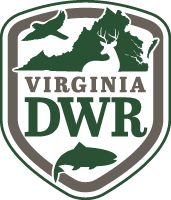Largemouth Bass
Largemouth bass fishing on tidal waters has been consistently good for the past several years. The Chickahominy and James rivers continue to be popular destinations for bass anglers with plenty of opportunities to catch 4–5 lb. fish and the potential to land larger fish in the 6–8 lb. range.
James River tributaries, such as Powell and Herring Creeks, have consistently been more productive than mainstem habitats for both juvenile and adult fish. This is also true for the tidal Rappahannock River, with upper tributaries and Green Bay offering the most consistent opportunities. The tidal Rappahannock bass population below Port Royal is lower compared to the 2010s, largely due to loss of aquatic vegetation. Numbers have been slowly increasing in recent years as vegetation has come back, and strong recruitment over the past three years bodes well for future population growth.
Pamunkey and Mattaponi bass populations have been consistent, with plenty of opportunities to catch 2–3 lb. fish in the Mattaponi and 3–4 lb. fish in the Pamunkey, with the potential to catch fish in the 5–6 lb. range. During high-water events and incoming tide, anglers might have better luck in small tributaries with shoreline structure.
Heading into spring, bass are more likely to be found along grass and spadderdock edges in two to three feet of water as they get ready to spawn. As water temperatures warm, fish will move into shoreline habitats with woody structure near channel drop-offs. Fallen trees and submerged logs and stumps are good places to target larger fish. Anglers should be aware that tides can produce strong currents in tidal rivers and tributaries. Many anglers prefer to fish during slack tide, the time around high or low tide when the current is not as strong.
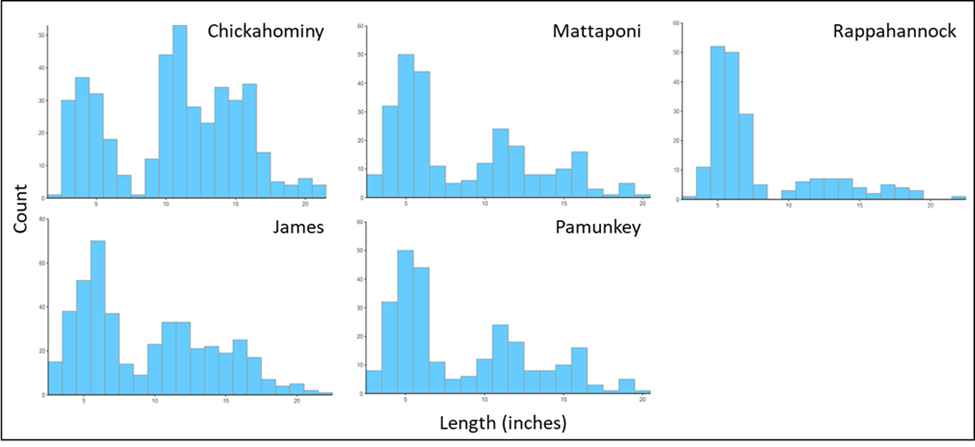
Invasive Alabama bass are still a concern in the James and Chickahominy rivers. In the tidewater region, Alabama bass have been found in Diascund Creek and the James and Chickahominy rivers. We are still asking anglers who think they have caught an Alabama bass to take a photo and contact DWR with information on where the fish was caught. DWR continues to monitor tidal waters, but help from anglers is critical.
Monitoring & Management
Largemouth Bass
The big storm events in fall 2024 caused high-flow events and dangerous river conditions that prevented annual sampling. The data presented this year is current up to 2023. DWR will be conducting bass sampling in spring 2025 to update data and provide a buffer against potential storms in fall.
Angler Survey
DWR just completed the Fall Line and tidal James River angler creel survey. Thanks to everyone who participated! The data collected helps DWR assess recreational use, effort, angler attitudes, and value of recreational fisheries. We will be analyzing results over the summer and will update constituents with the results later in the year.
Fishing Forecasts by River
Tidal Potomac River
Virginia tidal Potomac River tributaries south of Washington D.C. to Stafford County should provide good largemouth bass fishing in 2025. Bass catch rates in electrofishing surveys conducted in April and May 2024 were variable with excellent catch rates in creeks with good habitat (primarily SAV) and lower in creeks devoid of vegetation. Average catch rate for four study creeks (Little Hunting, Dogue, Pohick and Aquia) was 62 adult bass/hour, which was an increase from 2023 and above average. Catch rates in Pohick Creek were routinely over 100/hour and sometimes approached 150/hour in recent years. Bass reproduction in the past decade has been very good, with seven of 10 years above average, but 2022 and 2023 were below average. Look for fish on large woody debris on high tides before vegetation emerges and on Spatterdock bed edges later in spring. The Spatterdock flats outside creek mouths feeding the lower Occoquan (Belmont Bay) hold stunning numbers of bass in April and May. Snakehead fishing should be average in Aquia but below average in many other northern creeks below D.C., as numbers seem to have stabilized at lower abundance. Snakeheads are often easier to locate early in the season before aquatic vegetation emerges. Target flooded wetland vegetation and natural wood and docks on flood tides before spatterdock emerges, and then fish spatterdock edges at low tide before prior to SAV emergence. Once SAV is established, snakeheads can be found in any patch, especially Hydrilla.

Adult (red) and juvenile (blue) largemouth bass catch rates in tidal rivers since 2010. Catch rate is calculated as the number of fish collected per hour of sampling. Sampling is conducted via boat electrofishing every fall. DWR’s sampling design was changed in 2021 to better assess bass population health long-term. Significant changes in catch rates between pre-2020 and 2021-2023 reflect that change in design and not a sudden change in population health.
Tidal Rappahannock River (Fredericksburg to Port Royal)
Fishing for largemouth bass and northern snakehead should be excellent in 2025 in the tidal Rappahannock between Fredericksburg and Port Royal. This area of the river had an abundance of submersed aquatic vegetation (SAV) in recent years, which likely fueled catch rates of bass and snakeheads far above average. Adult bass catch rates in five of the past six years were the highest recorded in a quarter-century of surveys, and juvenile production was again above average in 2024, adding to six strong years of recruitment over the past eight seasons. A record spawn was recorded in 2023.
Target bass in creek mouths on outgoing tides and, of course, edges (and even inside) of thick mats of vegetation. Bass will also hold on large woody debris near channel edges, especially on lower tides. Snakehead abundance dropped for the second consecutive year after hitting a peak in 2022, but catch rates were still higher here than in most upper, tidal Potomac River tributaries. Look for snakes on the bank side (inside) of vegetation strips in very shallow water (sometimes inches deep).
Fishing for smallmouth bass on the upper Rappahannock and Rapidan Rivers (above Fredericksburg) in 2025 should be similar to last year. Like most rivers in eastern and central Virginia, high water during late spring in many recent has resulted in poor spawning success, and consequently smallmouth bass abundance has been depressed since 2020. The largemouth bass population has been expanding, and their numbers are strong on the slower stretches especially where SAV is present. Snakeheads can be found in these same slower, vegetated habitats; so weedless baits (soft plastics in spring, and topwater in summer) are a good choice. Look for snakeheads to stack up below Rapidan Mill Dam in mid-April through early May before they drop back from their pre-spawn migration.
The rivers are full of perfect eating-size channel catfish, which have colonized the upper watershed since Embrey Dam came down. Yellow perch, white perch, and striped bass can now also be found far above Fredericksburg with migration barriers gone.
Tidal Rappahannock River (Below Port Royal)
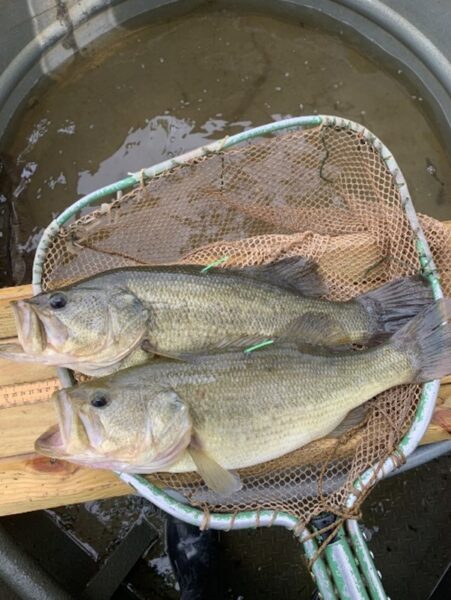 The tributaries of the Tidal Rappahannock River from Port Royal on down to Totuskey Creek provide a wealth of habitat for a variety of fish species. The electrofishing surveys of fall 2024 collected 33 fish species with a total of 2,836 fish collected. The Rappahannock River experienced high salinity levels during early to mid-September 2024 until the remnants of tropical systems hit the region. This pulse of fresh water flushed out the salinity wedge which had been a major inconvenience for electrofishing over the last few years. The low-pressure system that sat off the Atlantic Coast for an extended period of time created tidal flooding during early October. Numerous sites had water 1 to 2 feet above normal high tide stage. How much of an impact the high water had on the collection of certain fish species is hard to decipher.
The tributaries of the Tidal Rappahannock River from Port Royal on down to Totuskey Creek provide a wealth of habitat for a variety of fish species. The electrofishing surveys of fall 2024 collected 33 fish species with a total of 2,836 fish collected. The Rappahannock River experienced high salinity levels during early to mid-September 2024 until the remnants of tropical systems hit the region. This pulse of fresh water flushed out the salinity wedge which had been a major inconvenience for electrofishing over the last few years. The low-pressure system that sat off the Atlantic Coast for an extended period of time created tidal flooding during early October. Numerous sites had water 1 to 2 feet above normal high tide stage. How much of an impact the high water had on the collection of certain fish species is hard to decipher.
Anglers targeting largemouth bass east of Port Royal will find a decent abundance of fish in and around the dense mats of hydrilla growth. Some the better sites for bass in 2024 were the northern shore just west of Wilmont Landing, Jetts Creek, Gingoteague Creek, and the mouth of Mill Creek. The spatterdock pad fields on the southern shoreline across from Wilmont Boat Landing are always and attractive place to find bass. The 2024 surveys yielded a combined total of 174 largemouth bass for a catch rate of 24 bass/hr. This catch rate showed a decline from 2023 with the bulk of the decline found in the decreased catch of juvenile bass. The 2024 surveys did not yield many larger-sized bass with the best weighed in at just shy of 5 pounds.
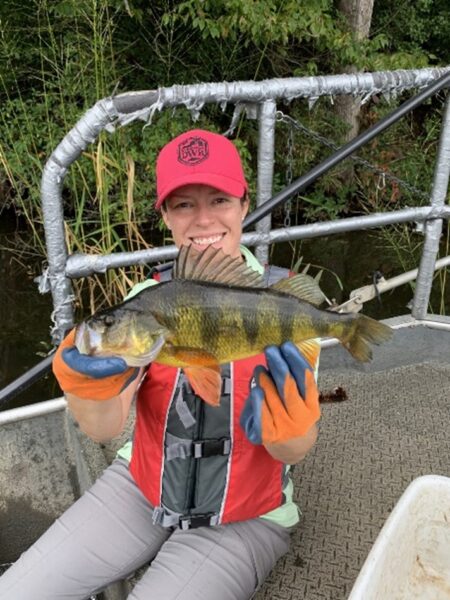 The survey years of 2022 and 2023 revealed consistent bass recruitment with an abundance of juvenile fish collected. From all indications the 2024 spawn was not nearly as strong as past years. Additional largemouth bass were tagged during 2024 as part of the tagging study that started in 2022. Anglers are encouraged to report any tagged bass they catch by calling (804) 829-6580. Anglers should try to take a picture of the specific # on the Floy tag and to leave the tag in the fish if released. Valuable data on fish movement and growth are what DWR staff are looking to gather from the study.
The survey years of 2022 and 2023 revealed consistent bass recruitment with an abundance of juvenile fish collected. From all indications the 2024 spawn was not nearly as strong as past years. Additional largemouth bass were tagged during 2024 as part of the tagging study that started in 2022. Anglers are encouraged to report any tagged bass they catch by calling (804) 829-6580. Anglers should try to take a picture of the specific # on the Floy tag and to leave the tag in the fish if released. Valuable data on fish movement and growth are what DWR staff are looking to gather from the study.
The Rappahannock River has been yielding some better than normal catches of blue catfish in the 30-to-50-pound range with reports surfacing of a few fish even larger. The 2024 survey found some very impressive blue catfish in the 40-to-60-pound range holding tight to shoreline cover in 2 feet of water. You never know where citation-sized fish might be found. The blue catfish population should still yield a sufficient abundance of 2-to-4-pound fish if anglers are looking to find a decent meal. Some of the better spots to try are the deeper holes in a few of the larger tributaries where the catfish will typically stack up.
The Tidal Rappahannock River continues to be a popular destination for anglers looking to get in on the action of the yellow perch run each spring. Most of this action can be found toward the tail end of February to the first couple weeks of March. Some of the lower tributaries in and around Tappahannock have seen their share of angler pressure. Anglers willing to battle the colder weather can find these fish stacked in certain pockets of the creeks during the months of December and January if ice coverage is not an impediment.
Recent DWR surveys have collected a decent abundance of yellow perch in the 10-12-inch range with a few fish pushing citation size. Most of these collections have been during the summer and mid-fall time frame and not during the spring run. Anglers are reminded that the minimum size limit for yellow perch is 9 inches for all tidal rivers of the Chesapeake Bay below the fall lines.
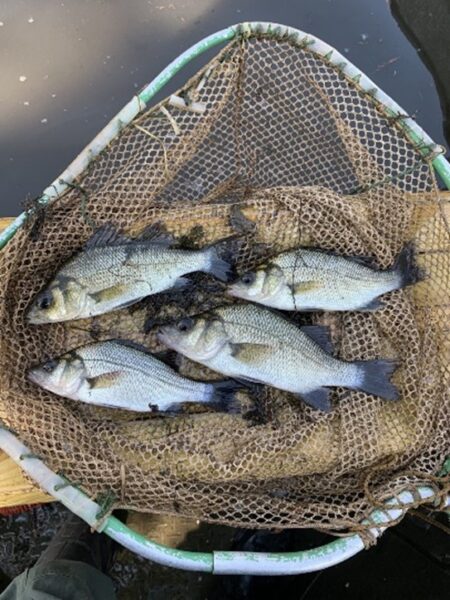 White perch are abundant in the Rappahannock River. The 2024 electrofishing surveys yielded a total of 244 white perch for a CPUE of 34 fish/hr. White perch were the third most abundant species behind only the Atlantic menhaden and eastern silvery minnow. Anglers might have to weed their way through numerous smaller fish in the 5–7-inch range to find larger-sized fish for the frying pan.
White perch are abundant in the Rappahannock River. The 2024 electrofishing surveys yielded a total of 244 white perch for a CPUE of 34 fish/hr. White perch were the third most abundant species behind only the Atlantic menhaden and eastern silvery minnow. Anglers might have to weed their way through numerous smaller fish in the 5–7-inch range to find larger-sized fish for the frying pan.
White perch are one of the tastier fish in the river system. Anglers fishing for white perch might also tie into the black crappie action. Some pockets of the river will hold decent black crappie in the 12-to-14-inch range. Large schools of crappie were not detected during the fall survey days. Certain downed trees with enough water depth will yield a dozen or so quality-sized fish. The 2024 survey did yield an uptick black crappie abundance with the majority of fish being in great physical condition.
Surveys have found scattered pockets of healthy bowfin in certain tributaries, but overall abundance showed a decline in 2024 with a limited catch rate of 4 fish/hr. The northern snakehead population also showed a decline in catch rate, dropping from 7 fish/hr. in 2023 to 2.6 fish/hr. in 2024. Many areas of the river have seen a large influx of bowfishing action with people trying their best to fill their freezers or feed all of their neighbors. The 2024 surveys showed a decreased presence of larger-sized redear sunfish in comparison to past survey years. Anglers are encouraged to limit their amount of shellcracker harvest during the spawn in hopes of letting their population rebound in the future.
Upper Piankatank River
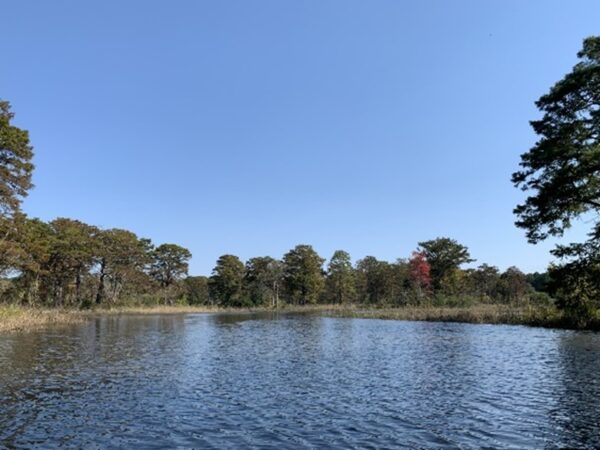 The Upper Piankatank River provides a scenic location for anglers. The nearest public boat ramp is quite some distance down river at the DWR Deep Point boat landing. Several miles upriver from the boat ramp, anglers will find plentiful amounts of marsh habitat lining the shorelines along with plenty of cypress trees. The fall survey of the Upper Piankatank River allowed for an assessment of the fishery with yielded a high species richness with 20 fish species collected. Five electrofishing sites were sampled on October 7, 2024, toward the upper end of the Piankatank River where it blends into the Dragon Run. The 2024 survey found an increase in largemouth bass abundance with 59 fish collected (CPUE = 43 fish/hr.). Bass recruitment of juvenile fish showed an increase from past years. The average sized bass weighed only 0.63 pounds due to the abundance of YOY (Young of Year) collected. The largest bass weighed 4.35 pounds. Anglers may be hard pressed to find any/many bass greater than 5 pounds in this stretch of the river but they should find a decent presence of 1-to-2.5-pound bass.
The Upper Piankatank River provides a scenic location for anglers. The nearest public boat ramp is quite some distance down river at the DWR Deep Point boat landing. Several miles upriver from the boat ramp, anglers will find plentiful amounts of marsh habitat lining the shorelines along with plenty of cypress trees. The fall survey of the Upper Piankatank River allowed for an assessment of the fishery with yielded a high species richness with 20 fish species collected. Five electrofishing sites were sampled on October 7, 2024, toward the upper end of the Piankatank River where it blends into the Dragon Run. The 2024 survey found an increase in largemouth bass abundance with 59 fish collected (CPUE = 43 fish/hr.). Bass recruitment of juvenile fish showed an increase from past years. The average sized bass weighed only 0.63 pounds due to the abundance of YOY (Young of Year) collected. The largest bass weighed 4.35 pounds. Anglers may be hard pressed to find any/many bass greater than 5 pounds in this stretch of the river but they should find a decent presence of 1-to-2.5-pound bass.
The catch of bowfin was once again impressive with 202 bowfin collected, up from the 178 collected in 2023. The bowfin population within the Piankatank River is one of the strongest within Virginia. The bowfin population showed an increase in average size, 2.6 pounds, up from the 2023 average size of 2.3 pounds. Very few bowfin will crack the 5-pound mark.
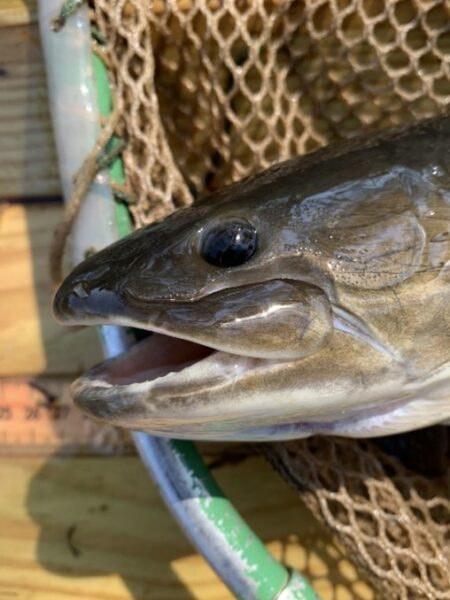 The fall survey did not find any northern snakehead. Past surveys have yielded a limited number of northern snakehead, so this was no huge surprise. The redear sunfish population has shown some great potential with 9 to 10-inch fish present. The survey showed an increase in pumpkinseed sunfish abundance. The black crappie population showed a higher catch rate in 2024 with fish up to 12.5 inches collected. Upper Piankatank River has a decent abundance of white perch with most fish running in the 7- to 9-inch range. Larger-sized white perch in the 10 -to 12-inch range have been reported by anglers fishing the more brackish water of the middle river.
The fall survey did not find any northern snakehead. Past surveys have yielded a limited number of northern snakehead, so this was no huge surprise. The redear sunfish population has shown some great potential with 9 to 10-inch fish present. The survey showed an increase in pumpkinseed sunfish abundance. The black crappie population showed a higher catch rate in 2024 with fish up to 12.5 inches collected. Upper Piankatank River has a decent abundance of white perch with most fish running in the 7- to 9-inch range. Larger-sized white perch in the 10 -to 12-inch range have been reported by anglers fishing the more brackish water of the middle river.
Anglers might encounter some decent chain pickerel in the tannin-stained waters of Dragon Run. The fall survey failed to catch any pickerel of substantial size. Past surveys have shown forage base limitations in areas of lower Dragon Run. These limitations might find predator fish more active and susceptible to strike properly placed lures and baits. The lower end sites showed an abundance of juvenile spot and large schools of eastern silvery minnows. There was definitely no shortage of forage in these areas. Only two juvenile striped bass were collected during the survey. The high-frequency electrofishing failed to find a single blue catfish in the fall of 2024.
For more information on Virginia’s Tidal Rivers, contact the respective regional office:
- Region 1: Charles City, VA 804-829-6788
- Region 4: Fredericksburg, VA 540-899-4169
